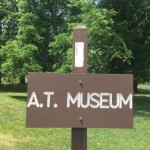
I live in central Pennsylvania near the halfway point of the Appalachian Trail (AT) and my favorite place, Pine Grove Furnace State Park, is at its epicenter. In a visit early this July (2016) the place was hopping. Thru-hikers, both end to enders and sectional hikers mingled with day users on the trail, which runs through the center of park. And there is a lot of outdoors to enjoy. However, it is generally only the distance hikers with calories to burn who stop by the park’s historic general store and attempt the half gallon challenge. Read more on this ice cream eating tradtion. Or cluster around the park’s limited electrical outlets to charge up their smart phones and catch up with friends and family. Lucky long distance hikers can even get a bunk bed at the park’s hostel. Known as the Iron Masters Mansion, it was once the impressive home of the owners of the nearby iron furnace. “Yes business has been very brisk this year” says the Mansion’s innkeeper Thom Morris, “but we were expecting it.”

Laurie Potteiger, a spokesperson for the Appalachian Trail Conservancy (ATC), confirmed that use of the trail is rising. The number of northbound thru-hikers passing through Harpers Ferry is up by 11% this year. Interest in the trail spiked after the publication of Bill Bryson’s amusing tale A Walk in the Woods (1998), which has been recently been released as a rather sappy movie starring Robert Redford and Nick Nolte. Pottegeiger noted that “We don’t have good data about what spurred the increases this year, but we have been seeing an increase of about 5-10% among northbound thru-hikers every year since about 2007. I have yet to talk to a thru-hiker who got 100% of their inspiration from the movie, but some were reminded of a long-held dream when they saw the film or the trailer and were inspired to take the plunge this year because of it.”
The rising numbers of users has raised concerns about overuse of the AT by some in the trail comment. However, what is of more interest to this writer is the lessons that the trail and the venerable ATC, the nonprofit organizations that manages the trail, offers to anyone interested in protected area management. The story of a long distance trail envisioned in the 1920s to run from Maine to Georgia and then actualized by the work of determined volunteers is well known. What is less discussed is how over time this resilient partnership model harnessed the efforts of trail clubs, state and local parks, private property owners as well as the power of federal funding and even eminent domain to secure the trails right of way forever. And how in 1984 the National Park Service entered into an unprecedented agreement with the Appalachian Trail Conservancy, a non-profit organization to take responsibility for the length of the trail.

Courtesy of the Appalachian Trail Museum
For this reason, it was a treat to read Sarah Mittlefehldt’s book Tangled Roots: The Appalachian Trail and American Environmental Politics (2013). The book covers the history of the early decades of the development of the trail. But the book really get interesting when she tackles the intersection of the trail with the growth of the environmental movement, the need to secure permanent protection for the pathway, and in particular the accommodations that had to be made with the rise in the property rights movement. Fittingly, she labels the introduction to her book The Tortuous Path toward Public – Private Partnership. Building on the book’s title she describes the creation of the AT of today as combining “the horizontal dendritic roots of grassroots social action with the strong central taproot of federal authority.”
A thru- hiker (2007) herself Mittlefehldt brings a close to the ground perspective on the value of the trail as well as a sensitivity to the viewpoints of local landowners and communities. I particularly like the recognition she gives of the working landscapes that the trail traverses. She applauds the ATC for its hard won efforts to maintain close relationship between the trail community and its neighbors. Also the ATC’s work to enhance economic and conservation opportunities through programs like Trail Towns, a Trail to Every Classroom, and Gateways community forums. Most importantly she recognizes that the success of the AT could a guide to how parks and protected areas will be acquired and managed in the future. Some of her closing thoughts on the lessons from the trail are:
- The value of building long term bipartisan leadership at the local, state and national level.
- The importance of a campaign of coordinated grassroots action that can operate on multiple scales from local to national.
- The pivotal role the federal government has played in protecting the AT’s fragile right of way.

Interestingly, in this political season, Mittlefehldt also takes the position that conservation is compatible with conservatism, arguing that the differences between political parties in many cases are not so much about the need to protect the environment, but about “the means by which decision makers propose to do it.” The principles of the AT that rest on decentralized community-based management, the role of the private sector volunteers all resting on the bedrock of patriotism and love of country are conservative values. She highlights the relationship between the environmental movement and traditional rural land uses of as a topic worthy of further exploration. The AT as it winds its way through working forests, farm fields, and community backyards illustrates both the tensions, compromises, and benefits of the trail’s people centered approach.
But to conclude this story, let us return to Pine Grove Furnace State Park. There just steps from the AT itself is a another gem the Appalachian Trail Museum . Through engaging exhibits and hard working volunteers , the museum connect park visitors and hikers with the history of the people who made and continue to make the AT possible. The museum, located in a repurposed grist mill, is a multi-purpose venue with a rest area that welcomes thru-hikers and a fun new children’s center – perfect for inspiring ambition in the next generation go all the way.
Tangled Roots: The Appalachian Trail and American Environmental Politics, Sarah Mittlefehldt, University of Washington Press (2013)


